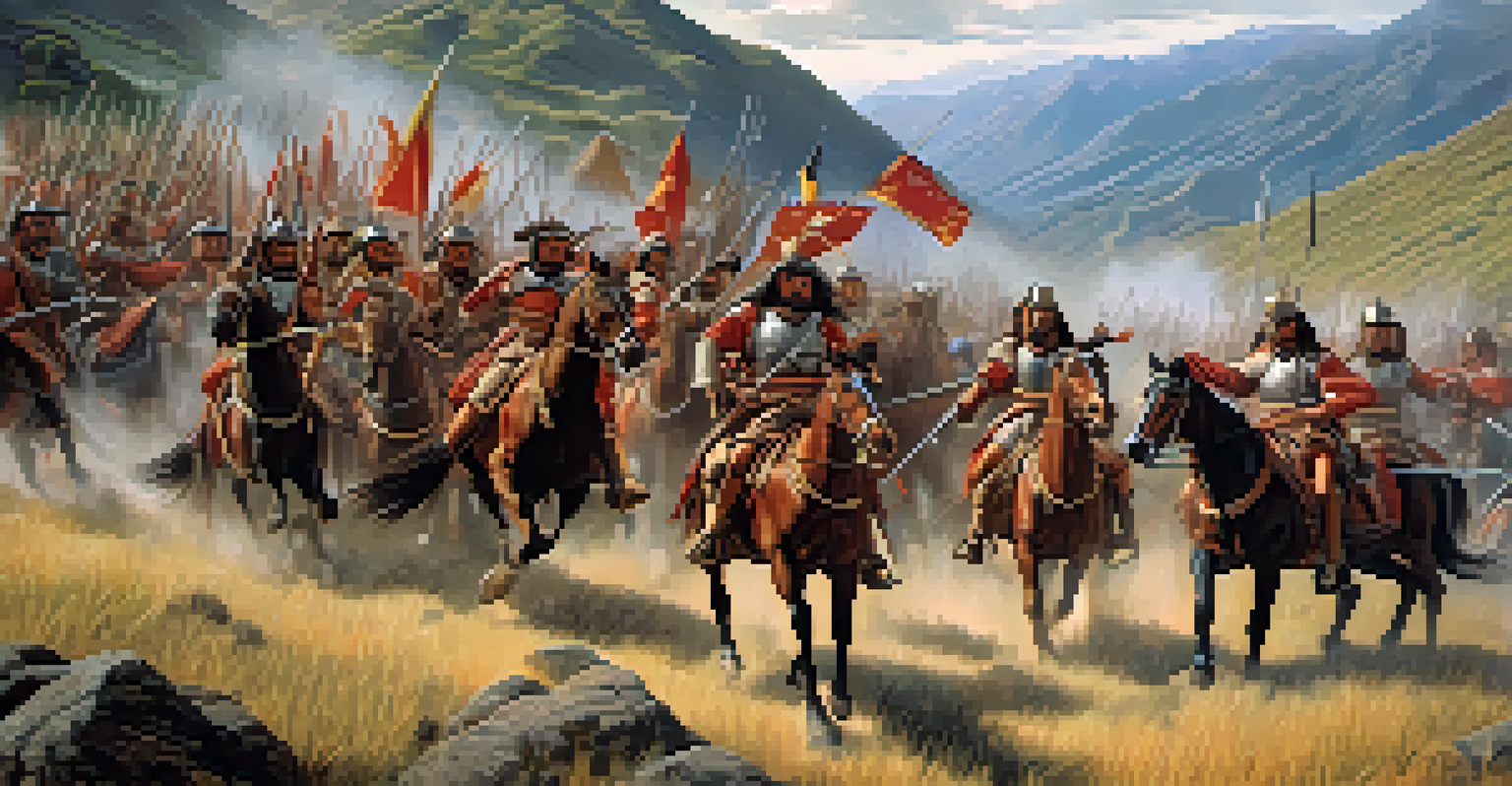Francisco Pizarro: Conquistador and Founder of Lima

Early Life of Francisco Pizarro: The Making of a Conquistador
Francisco Pizarro was born around 1471 in Trujillo, Spain, into a poor family. His father was a nobleman, but Pizarro's early life was marked by hardship as he grew up without formal education. This lack of privilege, however, did not deter him; it fueled his ambition and desire for wealth and adventure.
Conquest is not a matter of armies and weapons, but a matter of the spirit and the will to conquer.
In 1502, Pizarro sailed to the New World, joining expeditions in Central America. His experiences there, including encounters with indigenous cultures, ignited his passion for exploration. Pizarro's early ventures were setting the stage for his future conquest of the Incan Empire.
Amidst the backdrop of the Age of Discovery, Pizarro began to hone his skills as a leader and strategist. These formative years were essential in shaping his character and aspirations, leading him toward one of the most significant conquests in history.
The Rise of the Inca Empire: A Powerful Target
During Pizarro's time, the Inca Empire was one of the largest and most powerful empires in the Americas. Spanning a vast territory along the Andes mountains, it was known for its sophisticated governance and impressive architectural achievements. The Incas had a rich culture and a wealth of resources, making them an attractive target for European conquerors.

The empire was ruled by Emperor Atahualpa, who faced internal conflicts and civil war, weakening the empire's defenses. Pizarro saw this as an opportunity to exploit their vulnerabilities. His knowledge of the region, gained from previous expeditions, positioned him favorably for a successful conquest.
Pizarro's Ambition Fueled Exploration
Francisco Pizarro's early life hardships and experiences in the New World ignited his ambition for wealth and adventure, setting the stage for his later conquests.
Understanding the dynamics of power at play, Pizarro began to plot his approach to the Incas. His ambitions were fueled by the promise of gold and glory, ultimately leading him to set his sights on the heart of the Inca Empire.
The Conquest Begins: Pizarro's Bold Expedition
In 1532, Pizarro and his small band of men embarked on their expedition to conquer the Inca Empire. Armed with superior weaponry and a determination to succeed, they journeyed through treacherous terrain to reach the Inca heartland. Despite being vastly outnumbered, they relied on strategy and deception to gain the upper hand.
History is written by the victors.
Upon encountering Atahualpa, Pizarro orchestrated a dramatic ambush at the Battle of Cajamarca. The Spanish forces captured the emperor, using him as leverage to demand riches and secure their dominance. This pivotal moment marked the beginning of the end for the Inca Empire.
Pizarro's ability to exploit the political situation within the empire showcased his cunning as a conquistador. His actions would have lasting consequences for both the Incas and the future of Peru, setting the stage for a new era of Spanish rule.
The Fall of the Inca Empire: Consequences of the Conquest
Following Atahualpa's capture, the Spanish forces demanded an immense ransom, which the Incas paid in gold and silver. However, even after receiving the treasure, Pizarro executed the emperor, signaling the collapse of Inca leadership. This act of betrayal reverberated throughout the empire, leading to widespread chaos.
The Spanish conquest faced resistance from the remaining Inca leaders, resulting in a series of uprisings. Yet, Pizarro's military tactics and access to advanced weaponry ultimately overwhelmed the Incas. The fall of the Inca Empire was not just a military victory; it marked the beginning of a devastating colonization process.
Inca Empire's Vulnerability Exploited
Pizarro capitalized on the internal conflicts within the Inca Empire, which ultimately led to his successful conquest and the capture of Emperor Atahualpa.
Pizarro's conquest led to significant cultural changes, the introduction of European customs, and the forced conversion of indigenous peoples to Christianity. The Inca civilization, once thriving, faced dramatic shifts that would shape the region for centuries.
Founding Lima: The Birth of a New City
In 1535, Pizarro founded the city of Lima, naming it 'City of Kings' to reflect its importance and potential. The strategic location along the coast provided easy access to shipping routes, making it a vital hub for Spanish trade. Lima would become a center of Spanish power in South America.
Pizarro envisioned Lima as a prosperous city, planning its layout and infrastructure to facilitate growth. The establishment of Lima marked a significant shift in the region's political and cultural landscape. Over time, it would evolve into the capital of Peru and a focal point for colonial administration.
Despite its promising beginnings, the city also became a site of conflict and tension. Pizarro's leadership and vision for Lima would be tested as the complexities of colonial life unfolded, impacting both the indigenous population and Spanish settlers.
Pizarro's Legacy: Controversy and Impact
Francisco Pizarro's legacy is a blend of admiration and controversy. He is often celebrated for his daring exploits and strategic brilliance, yet his actions also resulted in immense suffering for indigenous populations. This duality reflects the complexities of colonial history, where conquest often came at a steep price.
As a conqueror, Pizarro significantly altered the trajectory of Peru's history, paving the way for the establishment of a colonial society. His conquests led to the influx of European settlers, the introduction of new agricultural practices, and significant shifts in the region's economy.
Founding Lima Transformed Peru
The establishment of Lima by Pizarro marked a significant shift in Peru's political and cultural landscape, paving the way for Spanish colonial power.
However, the consequences of his actions led to the decimation of indigenous cultures and populations due to violence and disease. Pizarro's legacy serves as a reminder of the profound impacts of colonization, prompting ongoing discussions about historical narratives and their implications.
Conclusion: The Enduring Influence of Pizarro's Journey
Francisco Pizarro's journey as a conquistador is a compelling tale of ambition, conquest, and transformation. His actions not only shaped the course of Peru's history but also left an indelible mark on the broader narrative of European colonization in the Americas. The founding of Lima stands as a testament to his legacy.
Today, Pizarro's story prompts reflection on the complexities of colonialism and its ongoing effects. As we explore the history of figures like Pizarro, we are reminded of the intertwined fates of conquerors and the cultures they encountered.

Ultimately, Pizarro's life and legacy challenge us to consider the broader implications of exploration and conquest, encouraging a deeper understanding of our shared history.